Why this resume works
- Quantifies accomplishments: By sharing metrics like a 15% rise in math scores and hosting events with over 300 attendees, the teacher’s measurable accomplishments reveal their significant impact on student success.
- Highlights industry-specific skills: The applicant’s skills in curriculum development and classroom management show their fit for teaching roles, directly tying to industry-specific competencies required in education.
- Illustrates problem-solving ability: Implementing technology-improved tools to boost reading levels by 20% showcases an innovative approach, illustrating strong problem-solving skills through creative educational strategies.
More Middle School Teacher Resume Examples
Our teacher resume examples offer great insights into highlighting your classroom management, lesson planning, and student engagement skills. Use these teaching resume samples to craft a strong resume that showcases essential abilities and relevant teaching experience.
Entry-Level Middle School Teacher
Why this resume works
- Centers on academic background: The applicant’s academic path, marked by a master’s degree in curriculum and instruction, lays a solid foundation for their teaching prowess in the early career stages.
- Shows digital literacy: By listing educational technology as a key skill, the applicant showcases computer skills essential for today’s tech-savvy classrooms.
- Puts skills at the forefront: Skills like curriculum development and classroom management are prominently placed, aligning with the skills-based resume format that benefits emerging educators.
Mid-Level Middle School Teacher
Why this resume works
- Points to measurable outcomes: By improving literacy rates by 18% and student performance by 20%, the applicant’s initiatives translate directly into measurable academic outcomes that reflect their effectiveness in education roles.
- Demonstrates language abilities: Language skills in Spanish and French expand the applicant’s ability to connect with diverse communities.
- Displays technical expertise: Holding certifications like Google Certified Educator Level 1 and leveraging educational technology shows the applicant’s adaptability in integrating modern tools into classroom environments.
Experienced Middle School Teacher
Why this resume works
- Showcases impressive accomplishments: Highlighting standout achievements like improving student performance by 20% showcases senior-level performance.
- Focuses on work history: The chronological resume format emphasizes their extensive work history, showcasing progressive teaching roles over time.
- Sections are well-organized: Bullet points and headers effectively organize sections, making the resume easy to scan and reader-friendly for those reviewing educational experience.
Middle School Teacher Resume Template (Text Version)
Olivia Martinez
Cincinnati, OH 45202
(555)555-5555
Olivia.Martinez@example.com
Professional Summary
Dedicated middle school teacher with 9 years’ experience. Proven success in improving student engagement and academic performance through innovative curriculum development. Expert in creating inclusive and tech-enhanced learning environments.
Skills
- Student Engagement
- Curriculum Development
- Classroom Management
- Diverse Learning Strategies
- Educational Technology
- Performance Assessment
- Project-Based Learning
- Communication Skills
Certifications
- Certified Middle School Teacher – Illinois State Board of Education
- Advanced Teaching Strategies – National Teaching Institute
Education
Master of Arts Education
Springfield University Springfield, IL
May 2016
Bachelor of Arts English
Illinois State University Normal, IL
May 2014
Work History
Middle School Teacher
Greenwood Middle School – Cincinnati, OH
March 2022 – August 2025
- Increased student math scores by 15%
- Organized annual science fair, 300+ attendees
- Collaborated in curriculum development for grades 6-8
Intermediate School Educator
Riverview Intermediate School – Columbus, OH
March 2017 – February 2022
- Boosted reading levels by 20%
- Led extracurricular art program, 150 students
- Implemented technology-enhanced learning tools
Junior Educator
Meadowfield Junior School – Columbus, OH
March 2016 – February 2017
- Facilitated small group activities to enhance learning
- Introduced project-based learning, engaged 50 students
- Developed adaptive lessons for diverse learners
Languages
- Spanish – Beginner (A1)
- French – Intermediate (B1)
- German – Beginner (A1)
Related Resume Guides
- Early Childhood Assistant
- Early Childhood Teacher
- Elementary Teacher
- English Teacher
- ESL Teacher
- Foreign Language Teacher
- French Teacher
- Fresher Teacher
- Graduate Assistant
- High School Teacher
- Homeschool Teacher
- Language Professor
- Montessori Teacher
- New Teacher
- Nurse Educator
- Physics Professor
- Piano Instructor
- Preschool Teacher
- Retired Teacher
- Social Science Teacher
- Spanish Teacher
- Student Teacher
- Summer School Teacher
- Teacher
- Teaching Assistant
- Tutor
- University Professor
Advice for Writing Your Middle School Teacher Resume
Whether you’re highlighting your teaching experience or showcasing your passion for education, understanding how to tailor your resume is key. Dive into our tips on how to write a resume for middle school teachers and discover how to effectively present your teaching skills and educational philosophy.
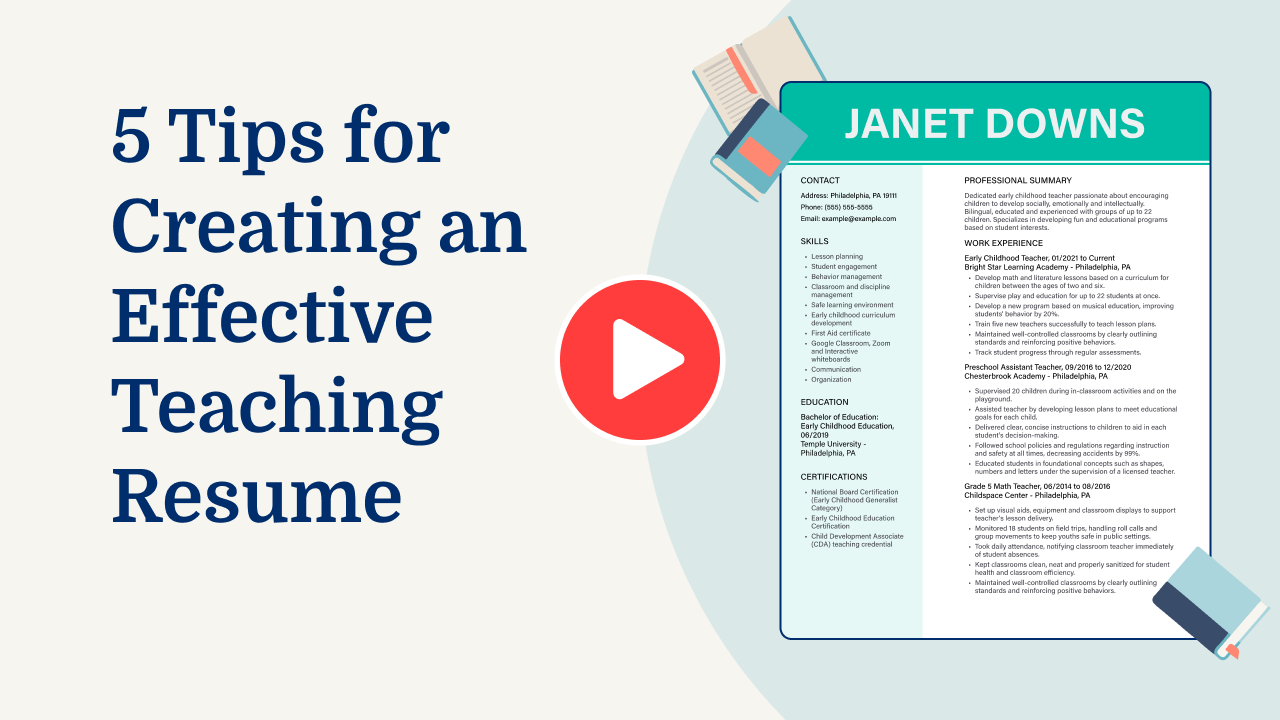
Highlight relevant certifications and training
For a middle school teacher, certifications and specialized training are essential for demonstrating expertise and a commitment to student success.
These credentials show that you have the skills and knowledge needed to create engaging lessons, manage classrooms effectively, and stay current with educational methods and technology. They also signal to hiring committees that you are dedicated to professional growth in a fast-evolving educational environment. Relevant certifications may include:
- State Teaching License (K–12)
- National Board Certification (NBPTS)
- TESOL/TEFL Certification (for teaching English language learners)
- Child Development Associate (CDA) Credential
- Google Certified Educator
Including a dedicated certifications section on your resume makes these qualifications highly visible. Highlighting relevant credentials demonstrates your professional development, reinforces your teaching expertise, and helps you stand out as a well-prepared candidate for a middle school teaching position.
Example of a certifications & training section
Middle School Mathematics Certification
Issued by: National Board for Professional Teaching Standards (NBPTS)
Issued 2021
Google Certified Educator Level 2
Issued by: Google for Education
Expires 2024
Child Development Associate (CDA) Credential
Issued by: Council for Professional Recognition
Completed 2020
Responsive Classroom Training
Issued by: Center for Responsive Schools, Inc.
Completed 2019
First Aid and CPR Certification
Issued by: American Red Cross
Expires 2023
Looking for ideas on how to make your resume stand out? Check out our professional resume examples to see how to best showcase your skills and past work.
List your most relevant skills
Being a middle school teacher requires a mix of technical and soft skills that help connect with students and manage classrooms effectively. Technical skills might include the use of educational software like Google Classroom or Zoom for virtual lessons.
Knowing how to create engaging presentations using tools like PowerPoint can also be helpful. Artistic abilities, such as drawing or music, can make lessons more lively and grab students’ attention.
Soft skills are just as important for a middle school teacher. Communication is key; you need to explain complex ideas in simple ways that kids can understand. Patience helps when students struggle with new concepts, while creativity keeps lessons interesting and fun. Empathy allows you to relate to students’ challenges and guide them through difficult times.
It’s smart to weave these skills into your work experience section instead of listing them separately. For example, you could describe how using Google Classroom improved student participation or how your artistic talents helped create memorable projects. This method shows employers not only what skills you have but also how you’ve used them successfully in real classroom situations.
Select a resume format that highlights your subject skills, student achievements, and classroom contributions to improve your application.
Write a strong professional summary
A professional summary on a resume serves as an introduction to hiring managers, helping them quickly understand who you are and what you offer. When crafting your resume, you’ll need to decide between using a summary or an objective statement. For middle school teachers, a strong summary can highlight experience and skills that make you stand out.
This brief paragraph showcases your experience, skills, and achievements and is best suited for individuals with significant work experience in their field. Its purpose is to convey your professional identity and demonstrate the value you bring to the role of a middle school teacher.
On the other hand, resume objectives focus on career goals. They’re ideal for entry-level applicants, those changing careers, or individuals returning to the workforce after a gap. We’ll provide examples of both summaries and objectives tailored for various levels of experience to inspire your resume introduction.
Middle school teacher resume summary examples
Entry-level
Enthusiastic new graduate with a Bachelor of Arts in Education and a teaching credential focused on middle school education. Experienced in classroom management and lesson planning through student teaching assignments. Skilled in integrating technology to engage students and certified in Child and Adolescent Mental Health First Aid. Committed to fostering a positive and inclusive learning environment.
Mid-career
Passionate middle school teacher with over six years of experience in developing curriculum for diverse classrooms. Proficient in designing interactive lessons that meet state standards while accommodating different learning styles. Notable achievements include increasing student engagement by implementing project-based learning strategies and leading the school’s science club to regional competitions.
Experienced
Seasoned middle school educator with more than 15 years of teaching experience and leadership roles, including department head. Specializes in curriculum development for STEM subjects, driving measurable improvements in student performance through data-driven instructional strategies. Expert at mentoring novice teachers and collaborating with parents to support student success both academically and socially.
Middle school teacher resume objective examples
Recent graduate
Dedicated and enthusiastic recent education graduate seeking a middle school teaching position to apply strong foundational knowledge in child development and curriculum planning. Committed to fostering an engaging and supportive learning environment that encourages student curiosity and academic growth.
Career changer
Passionate professional transitioning into middle school education, equipped with a background in communications and youth mentorship. Eager to bring strong communication skills and a fresh perspective to the classroom, aiming to inspire students and support their educational journey.
Specialized training
Newly certified teacher with specialized training in STEM education seeking a role at a forward-thinking middle school. Excited to use innovative teaching methods and technology integration to engage students in science, technology, engineering, and mathematics subjects.
Try our Resume Builder to create a standout resume quickly. It offers easy templates that highlight your teaching skills and experiences.
Showcase your accomplishments and publications
Listing your publications, conference presentations, and research accomplishments can really strengthen your resume as a middle school teacher. It shows that you are actively engaged in the academic community and keep up with the latest educational trends. Including a publications section early in your resume gives potential employers a sense of your expertise and dedication to teaching.
You should list peer-reviewed articles, book chapters, and conference papers clearly. Make sure to include citation details like journal name, volume, issue, and year following a professional style guide such as APA or MLA. Also, highlight any major awards, grants, or fellowships you’ve received related to your research or teaching methods.
This adds credibility to your profile and shows that others recognize your hard work and contributions. If you have online research profiles on platforms like Google Scholar or ResearchGate, consider adding links to these profiles within this section. This approach allows employers to easily access more detailed information about your work if they are interested.
Remember to keep it concise but informative by focusing on how these accomplishments make you an effective and innovative educator for middle school students.
Example of publications section
Publications
- Johnson, M. (2020). Developing Effective Lesson Plans for Diverse Learners. Featured in Middle School Teacher Resource Guide.
- Johnson, M. (2023). Interactive Strategies to Engage Middle School Students in STEM. Published in Teaching Today Magazine.
- Johnson, M. (2022). Incorporating Technology to Enhance Classroom Participation. Contributed article in Educational Innovations Blog.
- Johnson, M. (2021). Creative Approaches to Teaching Literature in Middle School. Presented at the State Middle School Educators Conference.
Choose a resume template that is clean and well-organized. Opt for simple fonts and clear headings so hiring managers can easily read your skills and experience.
Salary Insights for Middle School Teachers
Understanding salary data can help you make informed decisions about your career path and negotiation strategy. Explore key insights below to guide your research.
Top 10 highest-paying states for middle school teachers
Middle School Teachers earn varying salaries across the United States, with a national average of $66,387. The table below highlights the states where middle school teachers command the highest compensation.
Our salary information comes from the U.S. Bureau of Labor Statistics’ Occupational Employment and Wage Statistics survey. This official government data provides the most comprehensive and reliable salary information for middle school teachers across all 50 states and the District of Columbia. The figures presented here reflect the May 2025 dataset, which is the most recent available as of this publication.
| State | Average Salary |
|---|---|
| Washington | $94,230 |
| New York | $92,640 |
| California | $92,840 |
| Connecticut | $85,560 |
| Massachusetts | $85,230 |
| District of Columbia | $84,260 |
| Maryland | $79,000 |
| New Jersey | $79,750 |
| Rhode Island | $79,310 |
| Alaska | $78,550 |
FAQ
Do I need to include a cover letter with my middle school teacher resume?
Yes, including a cover letter with your middle school teacher resume is important. A cover letter allows you to express why you’re drawn to teaching at that particular school and discuss how your teaching philosophy aligns with their values.
For instance, if the school emphasizes STEM education or has a strong arts program, you can highlight your experience or interest in those areas.
Consider using our Cover Letter Generator to craft a personalized cover letter or create one from scratch by following guided steps and expert tips.
You might also find it helpful to look at cover letter examples specifically for teaching positions to ensure yours is compelling and relevant.
How long should a middle school teacher’s resume be?
For a middle school teacher, a one-page resume is often sufficient if you are just starting or have limited experience. This format helps highlight your key qualifications, teaching certifications, and relevant classroom management skills without overwhelming the reader.
If you’ve been teaching for several years or have significant involvement in extracurricular activities and professional development, a two-page resume may be more suitable. It allows you to detail your accomplishments while staying focused on meaningful content.
Understanding how long a resume should be depends on your career stage. Be sure to include only information that adds value and reflects your strengths as an educator.
How do you write a middle school teacher resume with no experience?
When crafting a resume with no experience for a middle school teacher role, emphasize your education, transferable skills, and any volunteer work or hands-on training that showcases your enthusiasm for teaching. Here are a few tips:
- Highlight your education: Start with your degree in education or related fields. Mention coursework in pedagogy, child development, or classroom management that aligns with middle school teaching.
- Include student teaching or internships: If you’ve completed student teaching, describe the grade levels you worked with, subjects taught, and any classroom strategies you used to engage students.
- Showcase relevant skills: Emphasize skills like lesson planning, communication, adaptability, and classroom technology skills (e.g., using Google Classroom).
- Add volunteer or extracurricular involvement: Include experiences like tutoring, mentoring programs, summer camps, or coaching that demonstrate your ability to connect with middle school-aged students.
- Tailor to the job description: Use keywords from the job posting to align your qualifications with what the school is seeking.
Crafting a strong resume with no experience is about showing how your background and enthusiasm make you an excellent fit for a middle school teaching role.
Rate this article
Middle School Teacher
Additional Resources
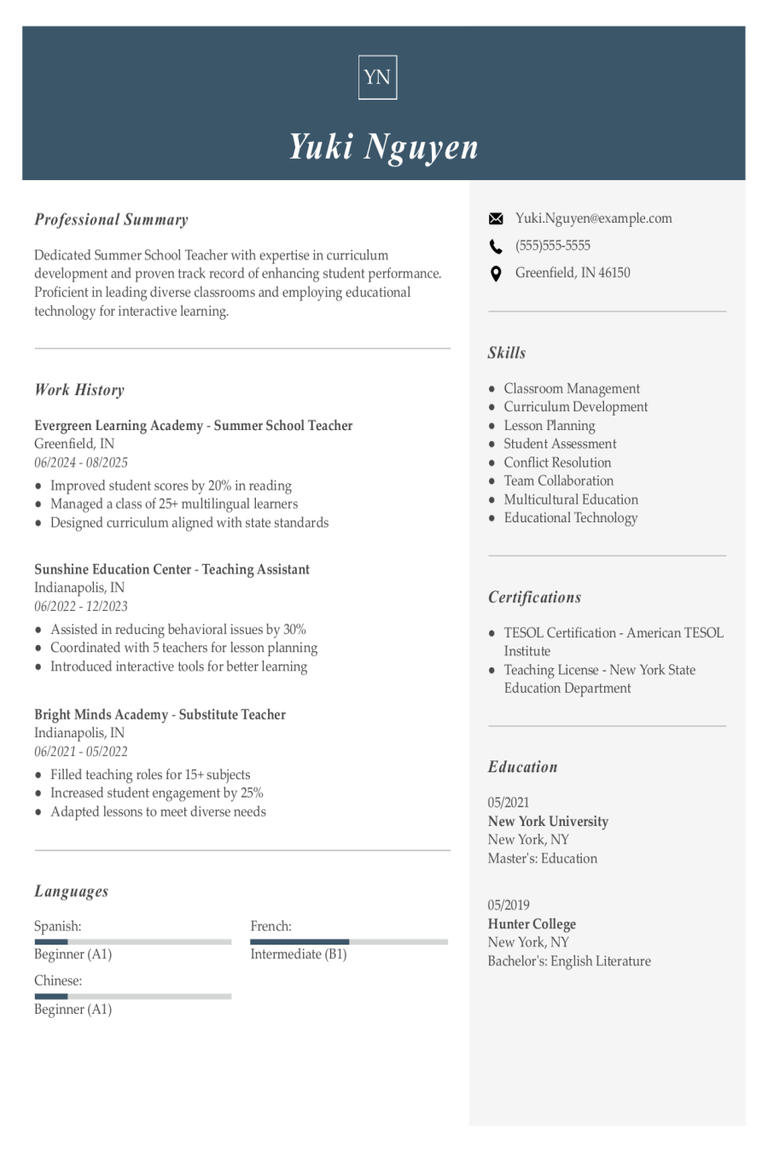
Summer School Teacher Resume Examples & Templates for 2025
Explore summer school teacher resume examples that focus on classroom management, lesson planning, and student engagement. Discover tips to show employers you’re creative, patient, and ready to inspire students.Build my
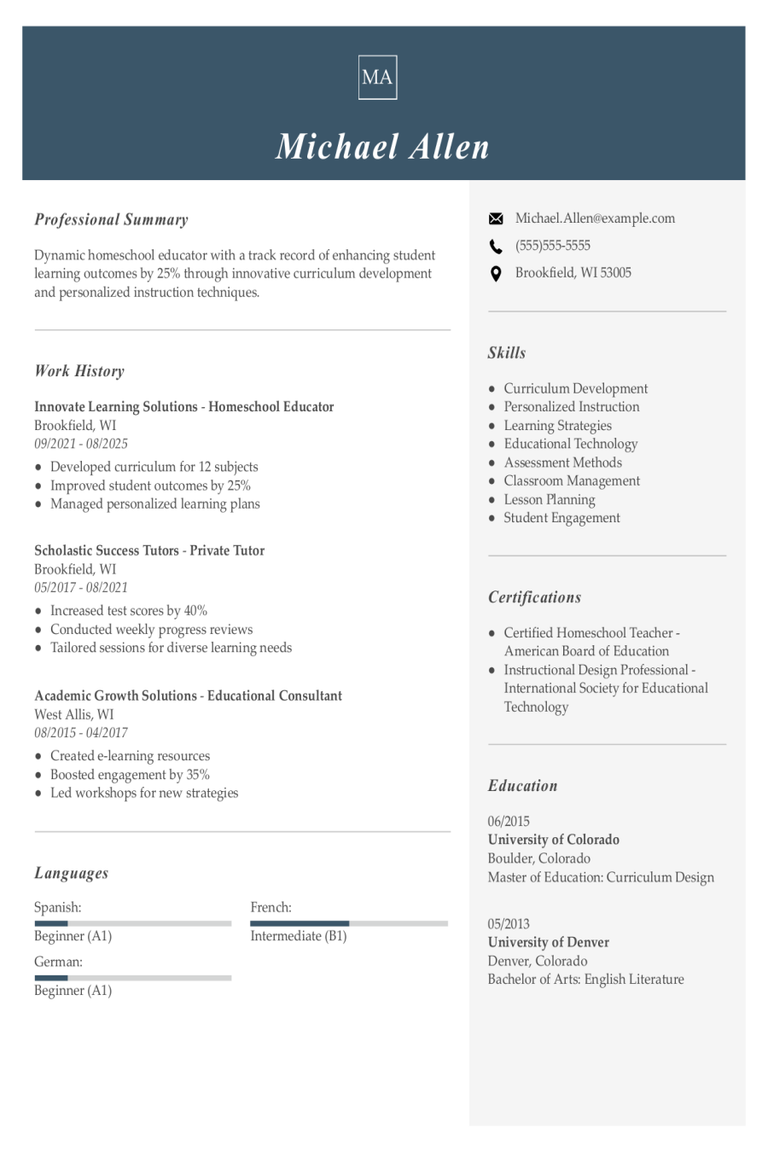
Homeschool Teacher Resume Examples & Templates for 2025
Looking to build a standout homeschool teacher resume? Our examples and tips will guide you in showcasing your teaching skills, curriculum planning, and ability to create engaging learning environments.Build my
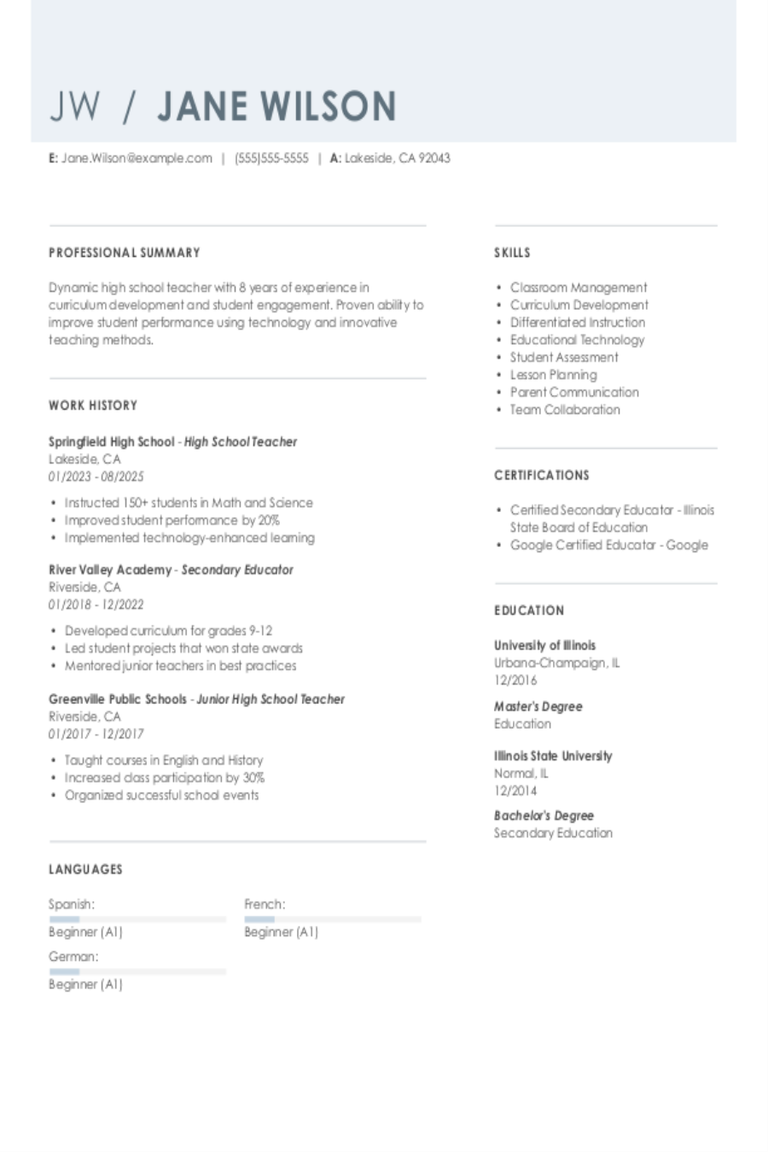
High School Teacher Resume Examples & Templates for 2025
Explore high school teacher resume examples that focus on engaging students and managing classroom activities. These tips will help you show off your teaching skills and highlight your relevant experience
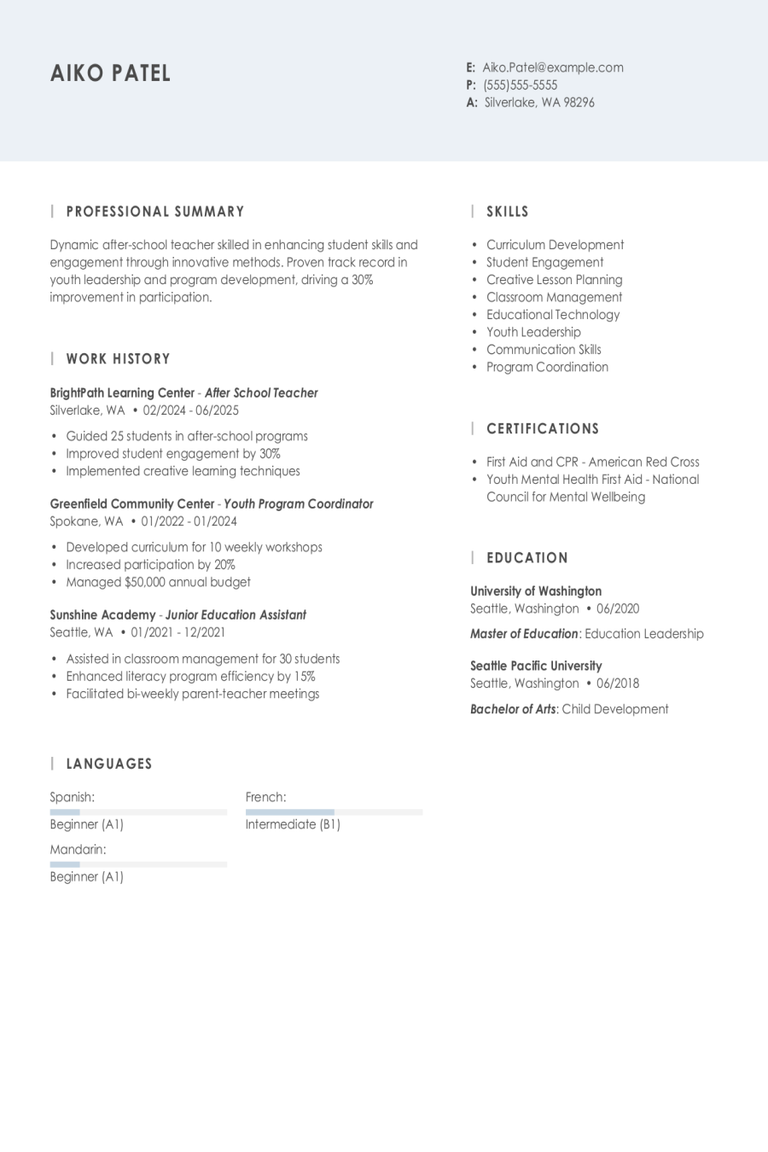
After School Teacher Resume Examples & Templates for 2025
Looking to build a strong resume as an after-school teacher? Our examples and tips will show you how to highlight your classroom skills and share relevant teaching experiences to stand
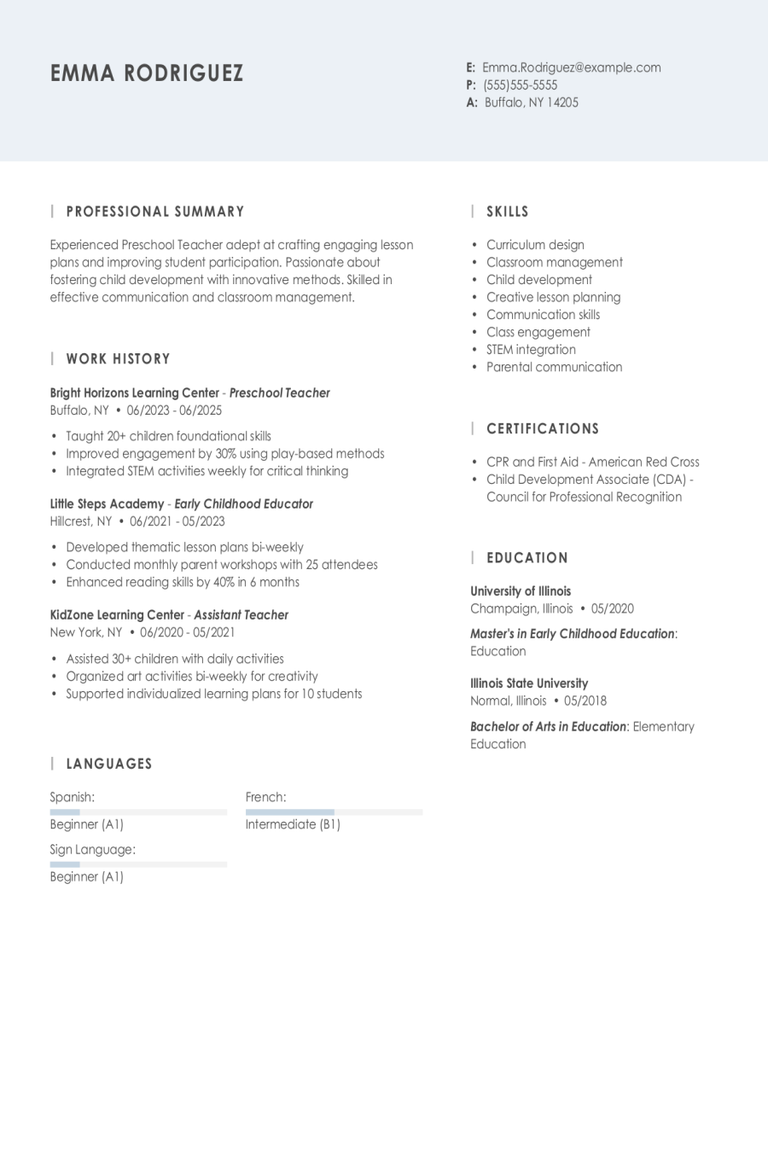
Preschool Teacher Resume Examples & Templates for 2025
Explore preschool teacher resume samples that emphasize creativity and communication skills. Learn how to make your experience stand out and show you’re ready to inspire young minds.Build my resumeImport existing

Preschool Teacher Cover Letter Example & Templates
Use the opportunity that the cover letter presents to show your unique qualifications for the position. Keep the tone professional, and never write more than a few paragraphs, following the
